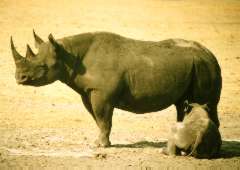Overview
 The rhinoceros has been on our planet for 60 million years. 30 species existed millions of years ago but today there are only 5 species - 2 African and 3 Asian. During the 1970s and 1980s more than 85% of the world's rhino population was killed, bringing this unique animal to the edge of extinction.
The rhinoceros has been on our planet for 60 million years. 30 species existed millions of years ago but today there are only 5 species - 2 African and 3 Asian. During the 1970s and 1980s more than 85% of the world's rhino population was killed, bringing this unique animal to the edge of extinction.
According to the IUCN:
The Greater One-Horned Rhinoceros, (aka the Indian Rhinoceros) is Vulnerable.
The Javan Rhinoceros is Critically Endangered.
The Black Rhinoceros is Critically Endangered.
The Sumatran Rhinoceros is Critically Endangered.
The White Rhinoceros is Near Threatened.
Daggers and Drugs
If the rhino didn't have a horn it would probably not be an endangered species - it wouldn't even be called a rhino since the name 'rhinoceros' is Greek and means 'horned nose'. For at least 2,000 years the rhino's horn has been in demand by some Middle and Far Eastern countries. In Yemen, tribesmen carve rhino horn into ceremonial dagger handles. These are held in great esteem, as they are said to give the owner strength and masculinity.
In the Far East, powdered rhino horn is used as a medicine. It is believed to cure all sorts of ailments such as coughs, fever, boils, measles, pain of childbirth etc. The horn is just a mass of compacted hair, so is it any good as medicine? Probably not in most cases, but in 1990 three Chinese doctors tested it and found that it did indeed lower the temperature of feverish mice and rats! They also tested water buffalo and cow horn and these were found to be just as effective.
Poaching and Poisoning
Although it is illegal to hunt rhinos, poachers are willing to risk the penalties - a poacher can make more money on a single horn than he can make on a farm in a whole year! In Africa, poaching gangs race into national parks in trucks, kill rhinos with machine guns, take off their horns and escape before the guards can stop them. Many guards and poachers have been killed in such raids.
In Asia, the 3 types of rhinos live in rainforests. Poaching is a problem but also the forest habitat of the rhinos is being destroyed to provide timber or land for building and farming.
Poisoning has been a problem for the Greater one-horned rhino since 1990. In the Chitwan National Park, Nepal, several have been killed by eating green maize cobs treated with a deadly pesticide.
Race to Save the Rhino
By the end of the 1980s conservationists thought the rhino was doomed to extinction. However, after 10 years of hard work, fighting the poachers and the trade in horn, some of the world's rhino populations are actually increasing!
In Africa, the game wardens are now more numerous and better equipped - some sanctuaries have actually been surrounded by electric fences. The most successful measures have been to persuade the Eastern countries to stop using rhino horn and substitute it with plastic or buffalo horn. Most of the countries concerned have made, and enforced, laws banning the import of rhino horn. Hopefully the remaining few will soon follow suit.
The fight will have to be continued for several years to come if we wish to prevent our remaining wild rhinos from disappearing for ever!
Approximate numbers of rhinos -
While there's no exact number, experts believe that only 27,000 to 30,000 rhinos are still alive today. “Two species are African: the black rhino, with 5,500 animals left, and the white rhino, with [around] 18,000 animals left,” says Emma Pereira, Communications Manager at Save the Rhino International.
Project
Find out more details about each of the five rhino species. Describe their differences in size, shape, habitat and way of life.
For more information on how to help save the rhino visit Save the Rhino International.
Credits
Image: Rhinoceros by Ray Morris
Information sourced from:
The IUCN Red List of Threatened Species (2015), Rhinoceros unicornis [online]. Available from: http://www.iucnredlist.org/details/19496/0 [accessed 01/08/2015].
The IUCN Red List of Threatened Species (2015), Rhinoceros sondaicus [online], Available from: http://www.iucnredlist.org/details/19495/0 [accessed 01/08/2015].
The IUCN Red List of Threatened Species (2015), Diceros Bicornis [online], Available from: http://www.iucnredlist.org/details/6557/0 [accessed 01/08/2015].
The IUCN Red List of Threatened Species (2015), Dicerorhinus sumatrensis [online], Available from: http://www.iucnredlist.org/details/6553/0 [accessed 01/08/2015].
The IUCN Red List of Threatened Species (2015), Ceratotherium simum [online]. Available from: http://www.iucnredlist.org/details/4185/0 [accessed 01/08/2015].
 The rhinoceros has been on our planet for 60 million years. 30 species existed millions of years ago but today there are only 5 species - 2 African and 3 Asian. During the 1970s and 1980s more than 85% of the world's rhino population was killed, bringing this unique animal to the edge of extinction.
The rhinoceros has been on our planet for 60 million years. 30 species existed millions of years ago but today there are only 5 species - 2 African and 3 Asian. During the 1970s and 1980s more than 85% of the world's rhino population was killed, bringing this unique animal to the edge of extinction.
